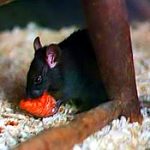A typical adult black rat is 12.75-18.25 in (32.4-46.4 cm) long, including a 6.5-10 in (17-25 cm) tail, and weighs 4-12 oz (110-340 g). Despite its name, the black rat exhibits several colour forms. It is usually black to light brown in colour with a lighter underside. In the 1920s in England, several variations were bred and shown alongside domesticated brown rats. This included an unusual green tinted variety.
It is nocturnal and omnivorous, with a preference for grains and fruit. Compared to the brown rat, it is a poor swimmer, but more agile and a better climber, tending even to flee upwards. In a suitable environment it will breed throughout the year, with a female producing three to six litters of up to ten young. Females may regulate their production of offspring during times when food is scarce, throwing as few as only one litter a year. R. rattus lives for about 2-3 years. Social groups of up to sixty can be formed.
Black rats, and their parasites, are able to carry a number of pathogens, of which bubonic plague (via the rat flea), typhus, Weil’s disease, toxoplasmosis and trichinosis are the best known. It has been hypothesized that the displacement of black rats by brown rats led to the decline of the Black Death. This theory has, however, been deprecated, as the dates of these displacements do not match the increases and decreases in plague outbreaks.

